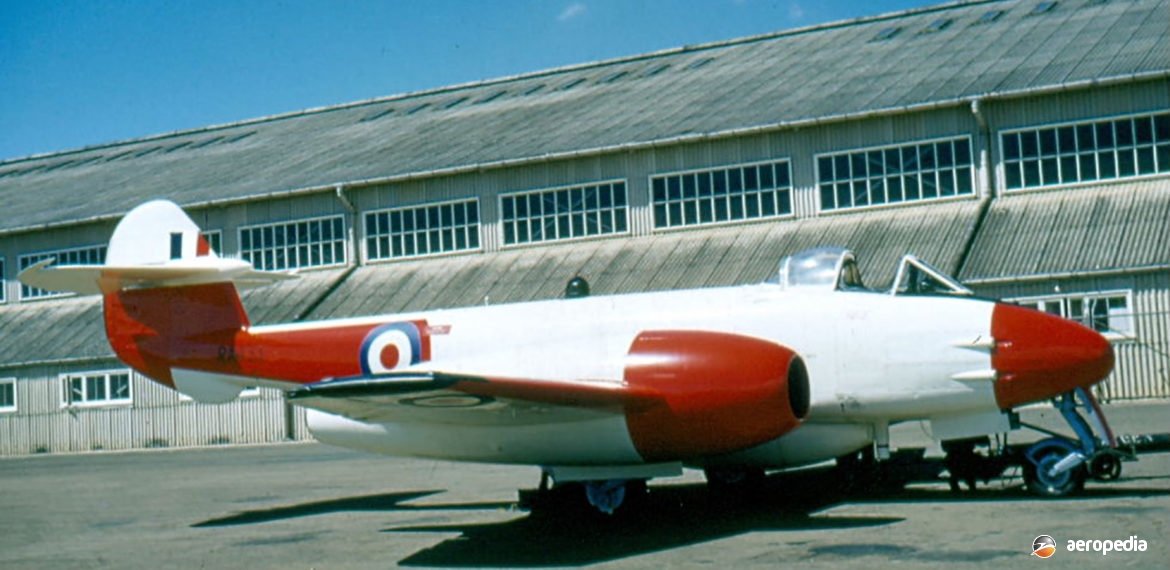Photograph:
Gloster Meteor U-15 RA433 at Bankstown, NSW in September 1958 (David C Eyre)
Country of origin:
Great Britain
Description:
Single-seat manned or unmanned drone
Power Plant:
Two 3,600 lbst Rolls Royce Derwent RD8 centrifugal-type turbojets
Specifications:
- (U-16 and U-21)
- Similar to Meteor F-8
Armament:
Four 20 mm fixed Hispano cannon in nose; racks for rocket projectiles under wings
History:
When the Royal Air Force (RAF) commenced retirement of the Meteor F.4 fighter it looked at converting a number to target drones to help develop ground and air-launched guided missiles. It was decided to convert a number to be used as expendable targets that could be tested to destruction. Up to this stage the conversion of Fairey Fireflys to U-8 and U-9 configuration had been used but their performance was not similar to fast Soviet jet-powered fighters and bombers and development of the Meteor F.4 proceeded in order to provide an aircraft with much higher performance.
A Meteor T-7 was initially converted and fitted with autopilot and equipment for the proposed U-16, a conversion of the Meteor F-8, the T-7 carrying out trials at the Royal Aircraft Establishment (RAE) Farnborough in Hampshire. Subsequently a contract was received by Flight Refuelling Limited of Tarrant Rushton to convert aircraft to this configuration, some 94 being converted, commencing in 1955. The first U-15 conversion was flown on 11 March 1955.
Conversion involved fitting additional radio equipment, a fully automatic pilot, a remote control system that could be used to control the aircraft from the ground, and wingtip camera pods which could be ejected automatically by radio command just before the missile impacted the aircraft. These aircraft could be piloted, or be entirely remotely controlled, or could carry a non-pilot observer. Records indicate a total of 130 F.4s was converted.
A total of 61 was delivered to the Woomera Weapons Research Establishment in South Australia between 1958 and 1963, the first un-manned flight there being made on 7 May 1957 when a drone was destroyed by a Fireflash missile. Another 20 aircraft were delivered to the RAF unit at Llanbedr in North Wales, the first flight there being made over Cardigan Bay on 17 July 1958. A few were also attached to No 728B Squadron of the Royal Navy (RN) at Hal Far air base in Malta.
As time went by the number of U-15 survivors diminished and, as the F-8 was being retired, a number of these had similar conversions undertaken, becoming the U-16. Subsequently the U-21 was developed, this also based on the F-8 fighter, this model having the electronic telemetry equipment of the U-16 but with a lengthened nose, work on this model commencing at Flight Refuelling Limited in 1962. The U-21 were aircraft converted in the United Kingdom, and U-21A were Australian conversions. All were fitted with ventral fuel tanks and Mk 3 Ampor pods,. The colour scheme was red and white, although this varied.
In Australia Fairey Aviation at Bankstown, NSW obtained kit parts provided by Flight Refuelling Limited and 15 aircraft were converted using ex RAAF aircraft. One of these was shipped back to the United Kingdom in July 1971 and converted to U-16 configuration, continuing in service until 11 October 2004, at which time RAF Llanbedr closed.
Drone aircraft known to be destroyed as targets at Woomera included the following U-21s with British serials: VZ455, VZ503, WE902, WE960, WF659, WH460 and WK879. U-21A aircraft with Australian serials included: A77-157, A77-193, A77-207, A77-802, A77-872, A77-873, A77-882, A77-884 and A77-422.
As the numbers of test aircraft diminished, instead of being destroyed the equipment was modified so that the test missile would miss the aircraft by a pre-determined distance, allowing for the drone to track the progress of the missile and then return to its home base. The aircraft brought to Australia were operated and maintained by the RAAF but were owned by the United Kingdom Ministry of Supply. Eventually the surviving U-15s were redesignated D-15, the D being for “drone” whereas previously the “U” had been for “unmanned”. One U-16 has survived and has been preserved at the Bentwaters Museum in the United Kingdom. None has survivee in Australia and it appears the survivors were scrapped by Hines Metals at Wingfield, SA in the 1960s.

